Facet Joint Sprain
Updated:
(Also known as Neck Sprain, Sprained Neck, Apophyseal Joint Sprain, Apophyseal Wry Neck, Zygaphophyseal Joint Sprain, Sprained Facet Joint)
What is a facet joint sprain?
A facet joint sprain is a common condition characterized by damage or tearing of the connective tissue (such as ligaments, cartilage and joint capsule) of one of the facet joints of the neck.
The neck comprises of many bones known as vertebrae. Each vertebra connects with the vertebra above and below via two types of joints: the facet joints on either side of the spine and the disc centrally (figure 1).
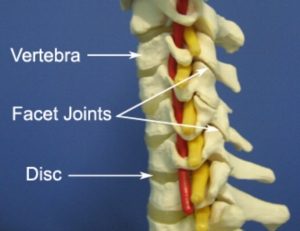
These joints are designed to support body weight and enable spinal movement. Each facet joint comprises of strong connective tissue wrapping around the bony ends and cartilage which lies between the bony joint surfaces, cushioning the impact of one bone on another.
During certain movements of the neck, stretching or compression forces are placed on the facet joint. If these forces are excessive due to too much repetition or high force, injury to the facet joint may occur. This may involve damage to the cartilage or tearing to the connective tissue surrounding the joint. When this occurs, the condition is known as a facet joint sprain.
Causes of a facet joint sprain
Facet joint sprains typically occur during excessive bending (i.e. forwards, backwards or sideways), lifting, slouching, or twisting movements of the neck. This may occur traumatically due to a specific incident (e.g. in tackling sports, such as rugby or wrestling) or due to repetitive or prolonged forces. They may also occur during sleeping particularly in poor posture (figure 2).
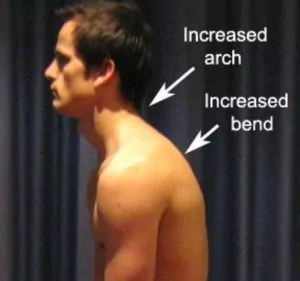
Signs and symptoms of a facet joint sprain
Patients with a facet joint sprain may experience a sudden onset of neck pain during the causative activity. However, it is also common for patients to experience pain and stiffness after the provocative activity, particularly the next morning.
Symptoms are typically felt on one side of the neck and muscle spasm may be experienced around the affected joint. Occasionally pain may be referred into the shoulder, shoulder blade, upper back or arm on the affected side. Symptoms are generally exacerbated with activities that involve turning the head, bending forwards or sideways, lifting objects, arching the head backwards or slouching for prolonged periods of time (e.g. when sitting – figure 2).
Diagnosis of a facet joint sprain
A thorough subjective and objective examination from a physiotherapist is usually sufficient to diagnose a facet joint sprain. Investigations such as an X-ray, MRI or CT scan may be required to confirm diagnosis and rule out other conditions.
Treatment for a facet joint sprain

Members Only ContentBecome a PhysioAdvisor Member to gain full access to this exclusive content. For more details see Become a Member. Already a member? Login Now
Prognosis of a facet joint sprain
The recovery time following a facet joint sprain may vary from patient to patient depending on the severity of injury and compliance with physiotherapy. With ideal treatment, patients may be pain free in as little as several days, although typically this may take 2 – 3 weeks. It is important to note, however, that injured tissue takes approximately six weeks to restore the majority of its strength in ideal healing conditions. Care must therefore be taken when returning to activity during this period.
Physiotherapy for a facet joint sprain
Physiotherapy for a sprained facet joint can hasten the healing process, ensure an optimal outcome and reduce the likelihood of recurrence. Treatment may comprise:
- soft tissue massage
- joint mobilization or manipulation
- traction
- electrotherapy (e.g. ultrasound)
- postural taping
- postural bracing
- dry needling
- the use of a lumbar support for sitting
- the use of an appropriate pillow for sleeping
- education
- activity modification advice
- ergonomic advice
- clinical Pilates
- exercises to improve flexibility, strength, posture and core stability
- a gradual return to activity program
Contributing factors to the development of a facet joint sprain
There are several factors that may contribute to the development of a sprained facet joint. These need to be assessed and corrected with direction from a physiotherapist and may include:
- poor posture
- poor ergonomic set-up
- neck or upper back joint stiffness
- a sedentary lifestyle
- poor core stability
- muscle weakness (e.g. the deep neck flexors)
- muscle tightness (e.g. the suboccipital muscles)
- inappropriate lifting technique
- a lifestyle involving large amounts of sitting, bending, slouching or lifting.
- Inadequate recovery periods from repetitive or prolonged neck movements (such as bending, slouching or twisting of the neck)
- Use of an inappropriate pillow during sleep
Other intervention for a facet joint sprain
Despite appropriate physiotherapy management, a small percentage of patients with a facet joint sprain fail to improve and may require other intervention. This may include investigations such as an X-ray, CT scan or MRI, pharmaceutical intervention, corticosteroid injection or referral to appropriate medical authorities who can advise on any procedures that may be appropriate to improve the condition.
Exercises for a facet joint sprain
The following exercises are commonly prescribed to patients with this condition. You should discuss the suitability of these exercises with your physiotherapist prior to beginning them. Generally, the initial and intermediate exercises should be performed 3 – 5 times daily, whilst the advanced exercises should be performed twice daily.
All exercises should only be performed provided they do not cause or increase symptoms.Your physiotherapist can advise when it is appropriate to begin the initial exercises and eventually progress to the intermediate and advanced exercises. As a general rule, addition of exercises or progression to more advanced exercises should only take place provided there is no increase in symptoms.
Initial Exercises
Chin Tucks
Begin sitting or standing tall with your back and neck straight, shoulders should be back slightly (figure 4). Tuck your chin in as far as you can go without pain and provided you feel no more than a mild to moderate stretch. Keep your eyes and nose facing forwards. Hold for 2 seconds and repeat 10 times provided the exercise is pain free. Repeat 3 – 5 times daily.
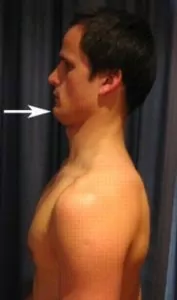
Shoulder Blade Squeezes
Begin sitting or standing tall with your back and neck straight (figure 5). Squeeze your shoulder blades together as far as you can go without pain and provided you feel no more than a mild to moderate stretch. Hold for 5 seconds and repeat 10 times provided the exercise is pain free. Repeat 3 – 5 times daily.
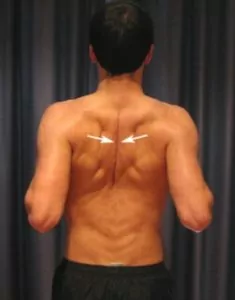
Neck Rotations
Begin sitting with your back and neck straight and your shoulders back slightly. Turn your head looking over one shoulder as far as you can go without pain and provided you feel no more than a mild to moderate stretch (figure 6). Then repeat the exercise turning your neck in the opposite direction. Keep your neck straight and don’t allow your head to poke forwards during the movement. Repeat 10 times to each side provided the exercise is pain free. Repeat 3 – 5 times daily.
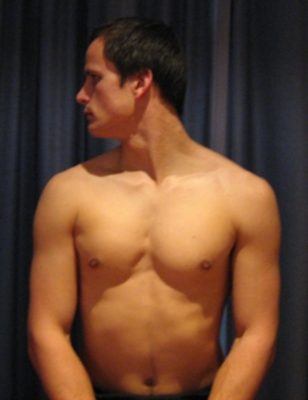
Intermediate Exercises

Members Only ContentBecome a PhysioAdvisor Member to gain full access to this exclusive content. For more details see Become a Member. Already a member? Login Now
Advanced Exercises

Members Only ContentBecome a PhysioAdvisor Member to gain full access to this exclusive content. For more details see Become a Member. Already a member? Login Now
Rehabilitation Protocol for a facet joint sprain

Members Only ContentBecome a PhysioAdvisor Member to gain full access to this exclusive content. For more details see Become a Member. Already a member? Login Now
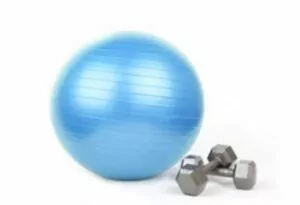 Physiotherapy products for a facet joint sprain
Physiotherapy products for a facet joint sprain
Some of the most commonly recommended products by physiotherapists to hasten healing and speed recovery in patients with this condition include:
-
 Wheat Bags
Wheat Bags -
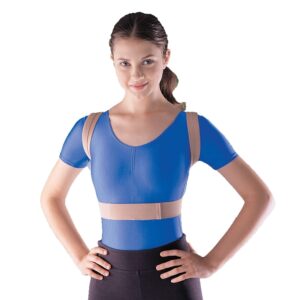 OPPO – Posture Aid / Clavicle Brace (OPP2075)
OPPO – Posture Aid / Clavicle Brace (OPP2075) -
 Premium Strapping Tape 38mm (Victor)
Premium Strapping Tape 38mm (Victor) -
 AllCare Pro-TENS Machine
AllCare Pro-TENS Machine -
 AllCare Tubing
AllCare Tubing -
 AllCare Spikey Massage Ball
AllCare Spikey Massage Ball -
 AllCare Instant Cold Pack (15 x 25cm)
AllCare Instant Cold Pack (15 x 25cm) -
 AllCare Foam Roller Round
AllCare Foam Roller Round -
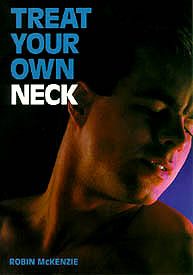 McKenzie Treat Your Own Neck Book
McKenzie Treat Your Own Neck Book -
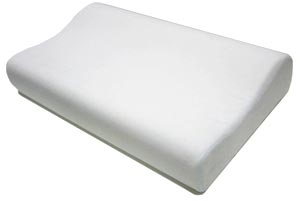 Dentons Impressions Classic Memory Foam Therapeutic Pillow
Dentons Impressions Classic Memory Foam Therapeutic Pillow
To purchase physiotherapy products for a facet joint sprain click on one of the above links or visit the PhysioAdvisor Shop
 Find a Physio
Find a Physio
Find a physiotherapist in your local area who can treat this condition.
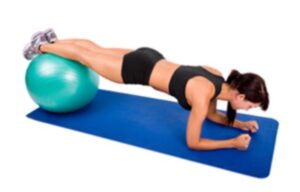 More Exercises
More Exercises
 Recommended Reading
Recommended Reading
- Correct Posture
- Postural Taping
- Mobile Phone Ergonomics
- Ergonomic Computer Setup
- Ice or Heat
- Initial injury management and the R.I.C.E. Regime
- Choosing a School Bag
- Return to Running following Injury
- Return to Sport following Injury
- Neck Diagnosis Guide
Become a PhysioAdvisor Member
-
 Individual Membership (12 Months)$59.95 for 1 year
Individual Membership (12 Months)$59.95 for 1 year -
 Individual Membership (3 Months)$39.95 for 3 months
Individual Membership (3 Months)$39.95 for 3 months -
 Individual Membership (Yearly)$49.95 / year
Individual Membership (Yearly)$49.95 / year -
 Individual Membership (Monthly)$15.95 / month
Individual Membership (Monthly)$15.95 / month

Link to this Page
If you would like to link to this article on your website, simply copy the code below and add it to your page:
<a href="https://physioadvisor.com.au/injuries/neck-head/facet-joint-sprain-2”>Facet Joint Sprain – PhysioAdvisor.com</a><br/>PhysioAdvisor offers detailed physiotherapy information on a neck sprain and facet joint sprain including: diagnosis, treatment, exercises, physiotherapy products and more...
Return to the top of Facet Joint Sprain.
